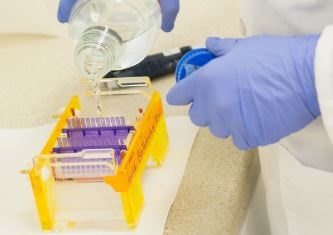3D printing technology is showing infinite manufacturing capabilities using a variety of materials, and now it’s innovating biotechnology. Researchers are discovering new ways to utilize this technique, creating cost-saving opportunities and novel gadgets for the lab.
So what is 3D printing? It’s a manufacturing process that is also known as “additive manufacturing,” and it involves the production of three dimensional objects using a digital file. It does this by working in continuous layers, building on a product until it’s finished. The process requires a computer aided design file which acts as the blueprint for the 3D printer. So with a little creativity, and either some technical skills or an open-source design, people are using this method to produce amazing things.
In laboratory research and development, there are 10 really fascinating products or concepts that have evolved from the emergence of 3D printing.
1. 3D Printed Chemicals:
It’s always exciting to see us catch up to "Star Trek" technology. And with the concept of 3D printing, we’re starting to approach the ability of having our own primitive Replicators. While it’s not quite 3D printing, this new technique for chemical synthesis has been described that way. Doctor Martin Burk of the University of Illinois and
Revolution Medicines is using 3D printing techniques to synthesize chemicals, simplifying the process. What this means for biotechnology and medicine is that drug discovery and research could become more affordable and accessible in the near future.
2. Fix Broken Lab Equipment:
When you use equipment, there will be accidents that will destroy a critical piece inside. Or sometimes time just takes its toll. Now, however, if one little piece breaks, you don’t have to spend hundreds of dollars replacing the part if you have a 3D printer. Instead, you can draft your design, print it out and pop it into place.
3. Gel Combs and Molds:
I have seen this example come up a lot. While you can find some inexpensive combs, a 3D printer allows researchers to save money by efficiently producing their own, and they can be more customized as well. Thankfully, with open-source designs, you don’t have to be too CAD literate to produce your own comb.

4. Sectoring Your Petri Dish:
Taking a Sharpie to a petri dish and dividing it out into sections for testing is among one of the first techniques a biology student will learn. But drawing those little lines equally and nicely takes a certain amount of skill when you’re starting out. So to ensure everything is equal and indeed in spec, Christof Osman designed the “Petristencillator” for Teklalab’s PrintMyLab contest. Seven master plates with grooves hollowed all the way through and divided into sections between two and eight were produced with a 3D printer. The master plates snap on a petri dish allowing anyone to draw evenly dividing lines. They’re reusable and they standardize the process. It would be handy for testing your antibiotics.
5. iPhone Microscope Mount:
You can now mount a digital camera to a microscope, but society is starting to move passed digital cameras. Anyone with a smartphone now has the power to take some quality pictures. And you can take a cellphone picture of an object in a microscope, but it takes some patience. Peter Combs, another PrintMyLab contestant developed a 3D printed mount for an iPhone 4 and a dissecting microscope. While this is fairly specific, it shows how 3D printing is a game changer for biotechnology. These mounts could be developed for any number of phones and microscopes at such an affordable rate, that every lab could have them.
6. Print Your Own Centrifuge:
Yep, that’s right. Rather than spending a few hundred dollars on a commercially available benchtop centrifuge, you can print your own. Again, with the open-source movement and the refined method of 3D printing, the technology is becoming available to the general population. In this example, another PrintMyLab contestant, Chris Takahashi, developed the “Fanfuge” for less than $10.
7. Robotic Surgery:
This doesn’t have a nice ring to it at all, which is exactly how 3D printing is solving the problem. Robotic assisted surgery has been around for a while as a way to adapt to some of our natural limitations. Of course, the idea of sharp, sterile, cold machines performing an operation seems really frightening, even when there are doctors around. Instead, 3D printed “squishy” robots may comfort patients a little better during a much needed procedure. And due to the manufacturing process, these robots have the potential to be far less expensive.
8. Nanotechnology and 3D Printing:
Combining nanotechnology and 3D printing is something that is still in its very early stages, but we are now standing in the doorway of thousands of possibilities. Nanotechnology such as DNA origami has alone stirred a lot of interest within the life science industry, but when paired with the manufacturing potential of 3D printing, it’s speculated to significantly advance medical treatments.
9. Hold Your Baby before He or She Is Born:
Just knowing the gender of a baby before he or she was born seemed like a huge step forward in medicine. Then came 3D ultrasound scans. Now 3D printing is taking us a step further by using software to print a 3D model of your unborn child. At first, it seems hard to wrap your head around the idea of becoming sentimental over an inanimate object; however, since touch is such an important and raw human experience, this innovation has led to some very emotional moments.
10. 3D Printed Tissue Scaffolds:
When you think of 3D printing, you might associate it with printing plastic trinkets and possibly some metal components. But innovations in 3D printing have brought us to a point where research scientists and medical engineers can print biocompatible materials. For example, the Wake Forest Institute for Regenerative Medicine uses this technology to print scaffolds for body parts that can be covered with cells and then grow into noses, bones, ears, etc.
These 10 examples only scratch the surface of what we can do with 3D printing. At its core, however, there are a few common revolutions that have come from this manufacturing process: It is
significantly reducing the cost of production, leading to more affordable consumption. It is significantly reducing the time spent producing products, allowing us to dream up more innovations at a faster rate. And it is fostering the “open-culture” where innovators are advocating for shared information in hopes of benefiting humanity.
 Karen Martin GoldBio Marketing Coordinator |
"To understand the universe is to understand math." My 8th grade math teacher's quote meant nothing to me at the time. Then came college, and the revelation that the adults in my past were right all along. But since math feels less tangible, I fell for biology and have found pure happiness behind my desk at GoldBio, learning, writing and loving everything science. |
Category Code: 79101





